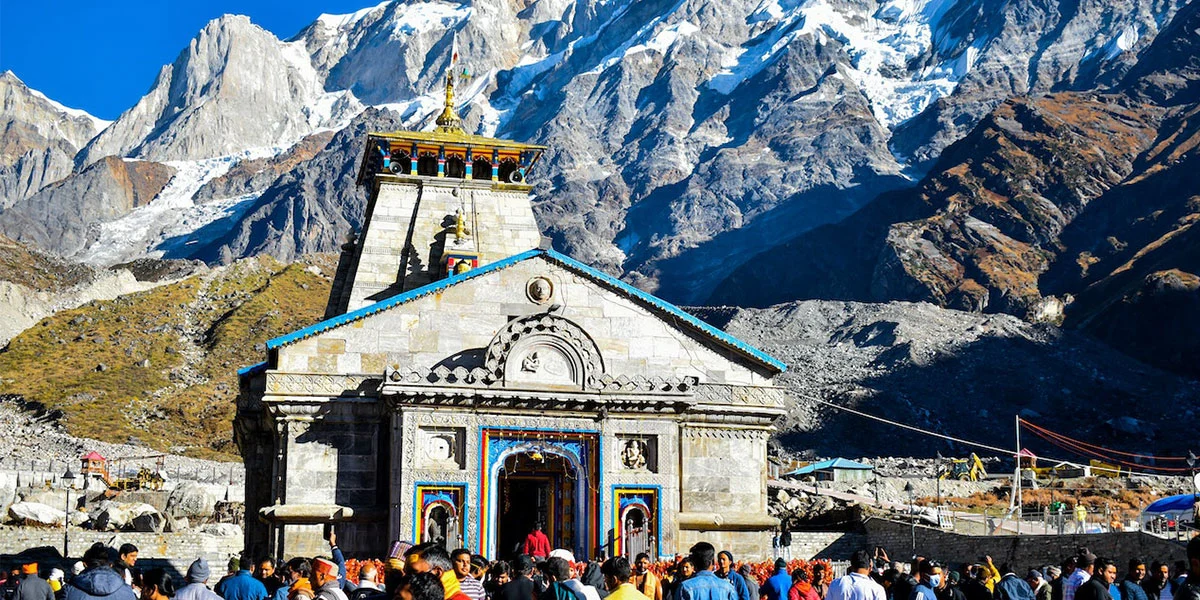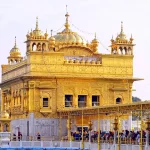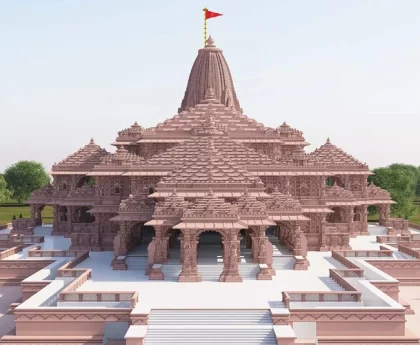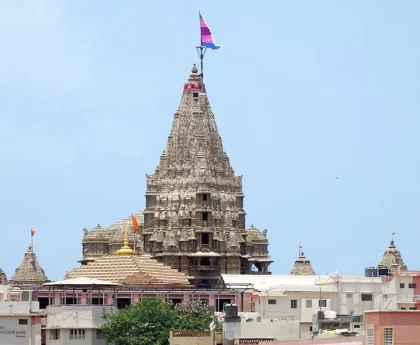Kedarnath is a town located in the Rudraprayag district of the northern state of Uttarakhand, India. It is renowned for the famous Kedarnath Temple, which is one of the holiest Hindu pilgrimage sites dedicated to Lord Shiva. The town is situated at an altitude of approximately 3,583 meters (11,755 feet) above sea level, making it one of the highest among the twelve Jyotirlinga shrines of Lord Shiva in India.
The Kedarnath Temple is believed to have been built in the 8th century by Adi Shankaracharya, a great Hindu philosopher, and reformer. The temple is constructed using large stone slabs and stands amid a breathtaking backdrop of snow-capped mountains and scenic beauty. Due to its remote location in the Himalayas, the temple is accessible only during certain months of the year when the weather is favorable.
Kedarnath attracts millions of pilgrims from all over India and the world, particularly during the pilgrimage season that typically runs from late April or early May to November. The main pilgrimage route to Kedarnath involves trekking for about 16 kilometers from a place called Gaurikund, where devotees start their journey on foot. Apart from this traditional trekking route, there are also helicopter services available for those who prefer a faster and more convenient way to reach the temple.
In recent years, Kedarnath gained attention due to a natural disaster that struck the region. In June 2013, the town was severely affected by flash floods and landslides, resulting in significant damage to infrastructure and loss of lives. Since then, extensive efforts have been made to rebuild and restore the region’s pilgrimage infrastructure to accommodate the visiting pilgrims.
Kedarnath remains an essential destination for spiritual seekers and nature enthusiasts alike, attracting visitors seeking both religious and recreational experiences amidst the serene and awe-inspiring Himalayan landscape.
History of Kedarnath
The history of Kedarnath dates back thousands of years and is steeped in Hindu mythology and legend. According to Hindu beliefs, Kedarnath is one of the holiest pilgrimage sites and is closely associated with Lord Shiva, one of the principal deities in the Hindu pantheon.
The origin of the Kedarnath Temple is attributed to the Pandavas, the heroes of the Indian epic, the Mahabharata. As the legend goes, after the Kurukshetra War, the Pandavas sought penance for their sins in the battle, as they had killed their own kin. They were advised that only Lord Shiva could grant them absolution. To find Lord Shiva, the Pandavas embarked on a journey through the Himalayas, where they encountered him in the form of a bull. Recognizing Lord Shiva, they tried to touch him, but he took refuge in the ground to avoid them.
The hump of the bull is believed to have appeared in Kedarnath, and the rest of the body parts were scattered in other four places, which together form the Panch Kedar pilgrimage circuit: Tungnath (arms), Rudranath (face), Madhyamaheshwar (navel), and Kalpeshwar (hair). These five temples are revered as sacred shrines and are essential pilgrimage destinations for Lord Shiva devotees.
The present-day Kedarnath Temple is believed to have been constructed by Adi Shankaracharya, the great Hindu philosopher and reformer, in the 8th century. He is credited with reviving and consolidating various Hindu sects and establishing the four main seats (mathas) in four corners of India. Adi Shankaracharya visited Kedarnath and renovated the temple to its current form.
Over the centuries, the temple has faced the challenge of maintaining its structural integrity due to its remote location in the Himalayas and the harsh weather conditions. Nonetheless, it has survived several natural disasters, invasions, and time, remaining a symbol of deep spiritual significance for Hindus.
In more recent history, as mentioned earlier, Kedarnath faced a devastating natural disaster in June 2013 when flash floods and landslides struck the region. The tragedy caused significant damage to the town and the temple, resulting in the loss of many lives. Substantial efforts were undertaken to rebuild the area’s infrastructure and restore the pilgrimage route to Kedarnath.
Today, Kedarnath continues to be a site of immense religious significance and attracts millions of devotees and tourists from around the world who seek spiritual solace and wish to witness the awe-inspiring beauty of the Himalayas. The pilgrimage to Kedarnath remains an essential aspect of Hindu religious and cultural heritage.
Significance of Kedarnath
Kedarnath holds immense significance in Hindu mythology, culture, and spirituality. It is considered one of the most sacred and revered pilgrimage sites for Hindus, particularly for devotees of Lord Shiva.
Several factors contribute to the significance of Kedarnath:
- Jyotirlinga: Kedarnath is one of the twelve Jyotirlingas, which are considered to be the holiest shrines dedicated to Lord Shiva. Each Jyotirlinga is believed to be a radiant manifestation of Lord Shiva and holds immense spiritual power.
- Panch Kedar: Kedarnath is part of the Panch Kedar pilgrimage circuit, along with four other temples – Tungnath, Rudranath, Madhyamaheshwar, and Kalpeshwar. The Panch Kedar temples collectively symbolize different body parts of Lord Shiva’s form. The Panch Kedar pilgrimage is an essential journey for Shiva devotees seeking blessings and spiritual fulfillment.
- Pandavas’ Connection: According to legend, the Pandavas built the original temple at Kedarnath after the Mahabharata war. The temple’s association with the Pandavas adds to its historical and mythological significance.
- Adi Shankaracharya: The present-day Kedarnath Temple is credited to Adi Shankaracharya, who renovated the temple in the 8th century. His contributions to Hinduism and the establishment of the temple as one of the Char Dhams (four main pilgrimage sites) elevated its importance.
- Blissful Setting: Kedarnath is nestled amidst the majestic Himalayan peaks, providing a serene and awe-inspiring backdrop. The natural beauty of the region enhances the spiritual experience for pilgrims and visitors alike.
- Absolution and Moksha: It is believed that a pilgrimage to Kedarnath and offering prayers to Lord Shiva can absolve one’s sins and grant liberation (moksha) from the cycle of birth and death.
- Shiva Ratri Celebrations: The festival of Maha Shivaratri, dedicated to Lord Shiva, is celebrated with great enthusiasm at Kedarnath. Thousands of devotees gather to participate in the festivities and seek blessings from Lord Shiva.
- Chota Char Dham Yatra: Kedarnath is part of the Chota Char Dham Yatra, which includes Kedarnath, Badrinath, Gangotri, and Yamunotri. This pilgrimage is considered highly auspicious and is undertaken by many Hindus seeking spiritual purification.
Due to its spiritual and cultural significance, Kedarnath attracts millions of pilgrims and tourists each year. The journey to Kedarnath, often involving a trek through the rugged Himalayan terrain, is considered a test of one’s devotion and dedication to seeking divine blessings. The experience of visiting Kedarnath and witnessing the holy shrine surrounded by snow-capped peaks is said to be profound and transformative for devotees.
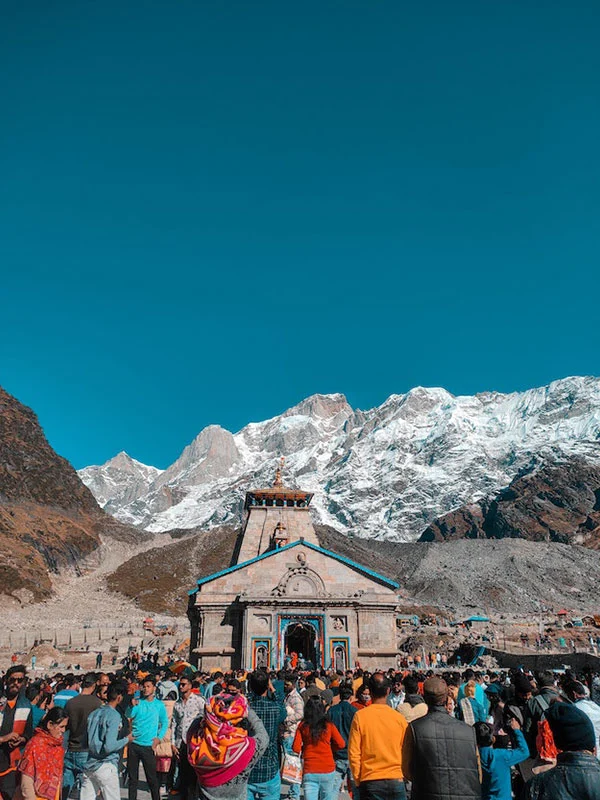
Best Time To Visit in Kedarnath
The best time to visit Kedarnath is during the pilgrimage season, which typically runs from late April or early May to November. The temple is open for devotees during this period, and the weather is relatively more favorable for travel and trekking in the region. However, the exact opening and closing dates of the temple can vary each year and are determined by the Hindu calendar and weather conditions.
Here is a breakdown of the different months and what to expect during each season:
- Summer (May to June): This is the peak pilgrimage season in Kedarnath when the temple is open for visitors. The weather is pleasant during these months, with daytime temperatures ranging from 10°C to 20°C (50°F to 68°F). It’s a good time for trekking and visiting the temple, but keep in mind that the region can still be chilly at higher altitudes.
- Monsoon (July to mid-September): The monsoon season brings heavy rainfall and the risk of landslides and flash floods in the region. Due to safety concerns, the Kedarnath Temple remains closed during this period. It is not advisable to visit Kedarnath during monsoon as the trekking paths become slippery and hazardous.
- Post-Monsoon/Early Autumn (mid-September to October): After the monsoon season, the weather starts to clear up, and the temple reopens for a short period. The post-monsoon months offer beautiful views of the lush greenery and the surrounding mountains. However, temperatures begin to drop, and nights can be cold.
- Late Autumn (November): This is the closing month for the Kedarnath Temple. The weather becomes chilly, especially at night, and there might be occasional snowfall in November. The temple closes around the time of Diwali festival, which falls in October or November.
It’s important to plan your trip according to the temple’s opening and closing dates, which can change from year to year. Also, be prepared for the changing weather conditions and carry appropriate clothing and trekking gear.
Avoid traveling during the monsoon season (July to mid-September) due to safety concerns and the temple’s closure. The best time to visit Kedarnath is during the summer months of May to June and the early autumn season of mid-September to October when the temple is open, and the weather is conducive to trekking and sightseeing.
How To Reach Kedarnath
Reaching Kedarnath involves a combination of road, trekking, and helicopter routes, as the temple is located in the remote Himalayas.
Here’s a step-by-step guide on how to reach Kedarnath:
- Reach Haridwar or Rishikesh: Haridwar and Rishikesh are well-connected cities in Uttarakhand. You can reach these cities by train, bus, or even by air (the nearest airport is the Jolly Grant Airport in Dehradun). From major cities in India, you can take a train, bus, or flight to reach Haridwar or Rishikesh.
- Travel to Sonprayag or Gaurikund: From Haridwar or Rishikesh, you can hire a taxi or take a shared jeep/bus to reach either Sonprayag or Gaurikund. Sonprayag is about 20 kilometers before Gaurikund, and Gaurikund is the last motorable point before the Kedarnath trek begins. It takes approximately 7-8 hours to reach Sonprayag and an additional 1-2 hours to reach Gaurikund.
- Trek to Kedarnath (Option 1): From Gaurikund, you have the option to trek on foot to Kedarnath, which is about 16 kilometers long. The trekking route is well-marked and moderately challenging. It takes around 6-8 hours to complete the trek, depending on your pace. The route offers beautiful views of the surrounding Himalayan landscape.
- Trek to Kedarnath (Option 2): If you prefer not to trek the entire distance, you can hire mules or ponies at Gaurikund to carry your luggage and ride them to Kedarnath. This reduces the physical exertion while still allowing you to experience the scenic beauty of the trek.
- Helicopter Service: For a faster and more convenient option, you can avail helicopter services from Phata, Sirsi, or Guptkashi, which are closer to Kedarnath. The helicopter ride provides stunning aerial views of the Himalayas and takes around 10-15 minutes to reach Kedarnath. However, helicopter services are subject to weather conditions and availability.
- Pony and Doli Services: At Gaurikund, you can also find pony and doli (palanquin) services for those who might have difficulty trekking or prefer a more comfortable way to reach Kedarnath.
- Stay in Kedarnath: There are several accommodation options available in Kedarnath, including guest houses, lodges, and dharamshalas. However, the availability of accommodation can be limited during peak pilgrimage season, so it’s advisable to book in advance if possible.
Before planning your trip to Kedarnath, check for the latest information on the temple’s opening and closing dates, as well as any travel advisories or restrictions in the region. Also, consider your fitness level and health condition before deciding on the trekking option, as the terrain can be challenging at certain points.
More information :- Kedarnath
It is safe to travel to kedarnath?
As of my last update in September 2021, traveling to Kedarnath is generally safe during the pilgrimage season when the temple is open for visitors.
However, certain factors need to be considered to ensure a safe and enjoyable journey:
- Weather Conditions: Kedarnath is located in the Himalayas, and weather conditions can be unpredictable, especially during the monsoon season (July to mid-September). Heavy rainfall can lead to landslides and flash floods, making it unsafe to travel during this period. The best time to visit Kedarnath is during the summer and early autumn months (May to June and mid-September to October).
- Health and Fitness: The trek to Kedarnath can be physically demanding, especially for those who are not accustomed to high-altitude trekking. It is essential to be in good health and fitness before attempting the trek. If you have any health concerns or medical conditions, consult your doctor before planning the journey.
- Trekking Preparations: If you choose to trek to Kedarnath, make sure to prepare adequately with appropriate trekking gear, comfortable shoes, and clothing suitable for the weather conditions. Carry enough water, energy snacks, and a basic first-aid kit during the trek.
- Acclimatization: If you are traveling from lower altitudes, it is advisable to acclimatize yourself in Rishikesh or Haridwar for a day or two before starting the trek. This helps your body adjust to the high altitude and reduces the risk of altitude sickness.
- Helicopter Services: If you prefer a quicker and more comfortable option, you can consider using helicopter services to reach Kedarnath. However, helicopter services are subject to weather conditions and availability.
- Guides and Porters: If you are trekking, consider hiring a local guide or porter who knows the trekking route well. They can assist you and ensure a safer journey.
- Respect Local Customs: Kedarnath is a religious site, and it’s essential to respect the local customs and traditions while visiting the temple and surrounding areas.
- Accommodation: During the peak pilgrimage season, accommodation options in Kedarnath might get limited due to high demand. Plan ahead and book your accommodation in advance if possible.
Always check for the latest travel advisories and updates from the local authorities before planning your trip. The safety and well-being of travelers are paramount, so it’s essential to stay informed and make informed decisions while traveling to Kedarnath.
More information :- Kedarnath
If you don’t like this article/post please share your feedback.

